Guitar
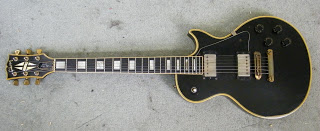
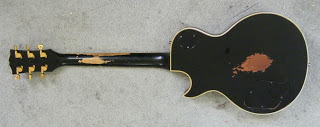
A customer recently brought me a Les Paul Custom from 1979. He's owned the guitar a long time but in the last few years it's been relegated to the case. He wanted to be playing it again so brought it to me to get it back into playing condition.
Its in desperate need of some care, love and a new set of frets.
While doing the job I'm going to take the opportunity to show you around her. We don't all have the chance to see inside lovely old guitars every day like I do.

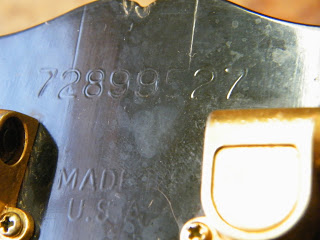
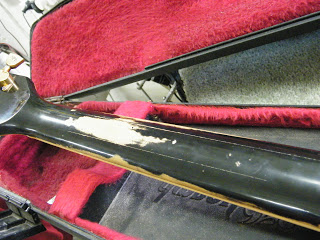
The back of the neck shows a lot of playing wear. And the 3 piece maple neck with the volute that Gibson were using at this time.
A maple neck is very hard to break especially when its made of 3 pieces. It does sound different though. Maple is very hard and heavy compared to the usual Mahogany. Maple has a toppier more biting sound than the more mellow chiming Mahogany. I rather like the Maple necked Les Pauls, I'm not really a Gibson purist.
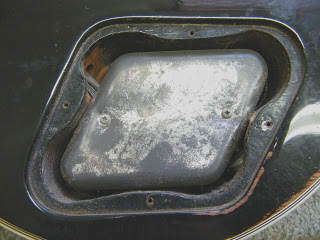
Taking the back cover off I find the Faraday Cage typical of this period. It adds some extra electromagnetic shielding though Les Pauls really don't need it and Gibson didn't fit them for long.
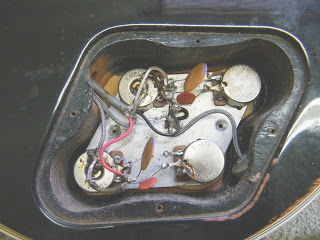
Taking that cover off I find a couple of the pots have been changed (it is an old guitar). And treble bleed capacitors have been added to the volume controls (those large brown discs) to prevent treble "roll off" when the volumes are turned down. They're not original but the customer will be really used to the way they work so I leave them in.

The jack socket is encased in a metal box which is again typical of the era and a bit of overkill on Gibson's part.
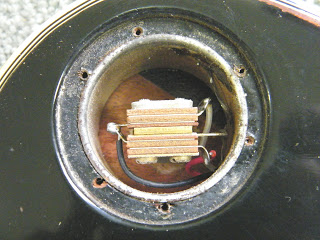
The 3 way switch is Gibson and surrounded by a metal sleeve. You can see the back plate has been fitted in a couple of ways - odd considering it's round.
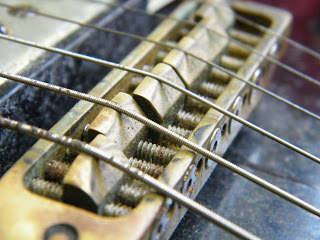
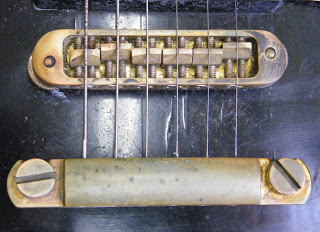
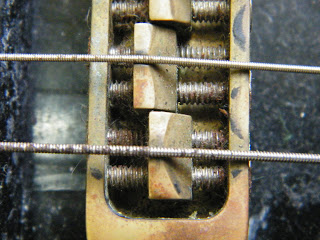
Both bridge and tailpiece have been changed to very solid brass ones. The customer tells me he was sick of fitting new Gibson bridges only to have them sag in the middle. He's had no problems with this one.
A lot of brass hardware was fitted during the '80's - we all thought it would give better harmonics.
I'm a big fan of some of the lighter alloy bridges and tailpieces these days.
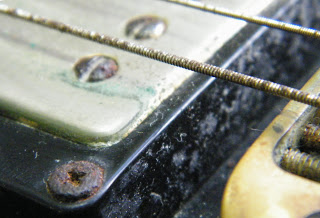
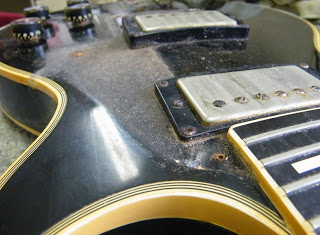
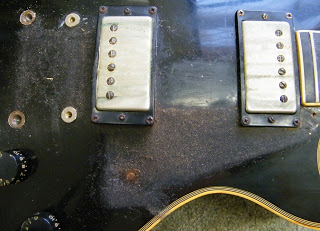
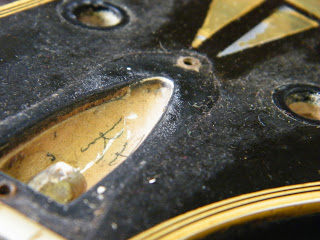
The general condition is a bit scruffy but nothing that some "Mr Glyn's Luthier's Finest " guitar polish (www.luthiersfinest.com) can't sort out.

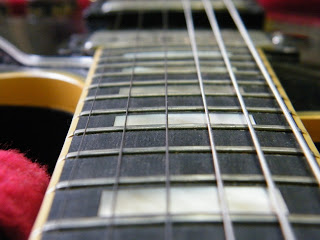
The only real problem with this lovely old Les Paul is the frets. They are simply worn out.
A re-fret is a routine job for me but Gibsons with bound necks pose an extra problem.

Gibson binding goes over the fret ends.
Those small pieces of plastic are very important for the instrument's value and authenticity. I've seen too many re-frets done where the binding has been completely ignored with those little pieces of binding filed off and the frets laid on top of them like an Epiphone.
It takes a bit of extra care to keep them but it is worth it.
It could be another 35 years before she's up for another re-fret. I'd like to think of a luthier in the future wondering if these are the original frets rather than cursing me for taking a shortcut.
I've covered re-fretting before (http://mrglyn.blogspot.co.nz/2008/11/maton-phil-manning-re-fret.html) so I'm not going to repeat myself.
This blog entry is all about saving the little wee pieces of binding.
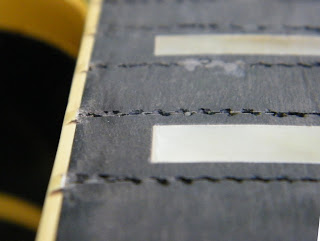

I start by removing the frets taking care not to hurt the binding.

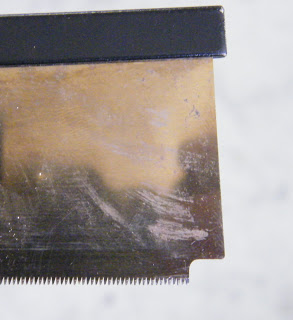
Then I clean the bottom of the fret slots using a Japanese saw. As you can see I've ground the end of the saw so I can get right into the corners. These saws differ from western saws in that they cut on the pull stroke, not the push. It makes them very accurate and controllable. And what a cool looking tool :-)
The tricky part of the job is cutting the frets to the exact size to fit inside the binding. Any gaps, especially on the treble side will mean the string will fall into the slot.
Gibson bind their guitars after the frets are in but I'm not keen on changing the binding and then touching up the lacquer - I only want to change the frets.
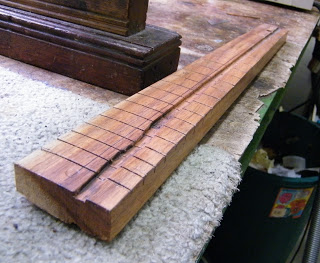
I use the principle of Occam's Razor - the simplest solution is the best.
I have made a "dummy" Les Paul Custom fretboard. It is exactly the same width all the way along and the frets are placed in the exact same places. The fret slots are just a tiny bit wider than normal.
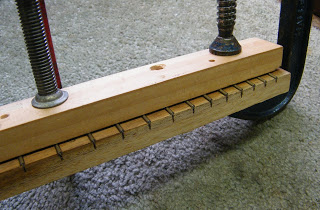
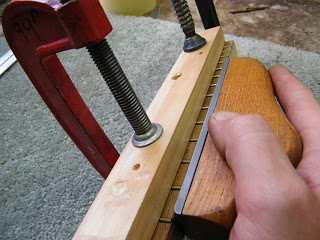
I fret this dummy board as usual, clamp the frets in place so they don't move and file the fret ends flush.

I've now got a full set of exact sized frets - simple.

I pull the frets out easily - the slots are wider so they just slip out. The channel I've routed down the face of the dummy board helps.
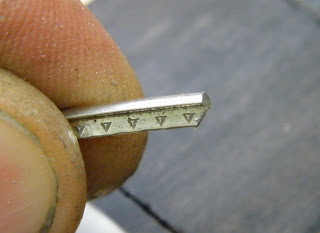
I file a slight angle at the end of the fret tang just in case there's some debris is the fret slot that the saw missed.
Then it's just a straightforward re-fret.
Here's some info on the fret stoning method I use - http://mrglyn.blogspot.co.nz/2012/01/fret-stone-fender-stratocaster.html
And I always oil rosewood or ebony fretboards with "Mr Glyn's Luthier's Finest" fretboard oil: www.luthiersfinest.com
It gives it great protection and looks nice too.

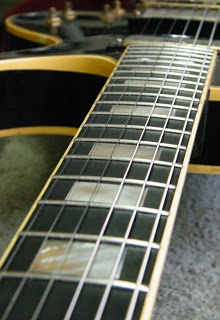
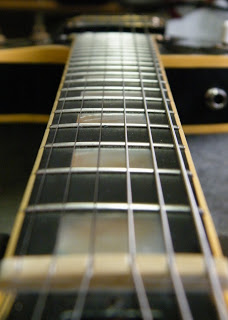
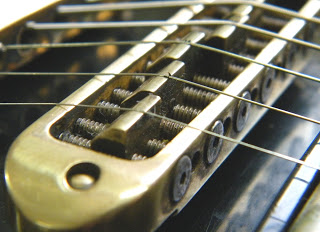
I give all the hardware a good polish as part of the set up.

The difference in tone was huge. The strings vibrating off a well crowned, polished frets rather than flattened, dull frets.
I think of a re-fret as re-newing the playing surface, she's still the same lovely old guitar but now plays and sounds better than ever.
Life in the old girl yet
Cheers
Glyn
Feel free to contact me about repair work (if you are in NZ). The workshop phone is always the best 09 307 6501.
- Fret Stone - Fender Stratocaster
Frets wear. Eventually they wear out and need replacing. If the wear is not too deep the frets can be ground down to the lowest point of the wear, re-crowned, polished and the guitar is ready for a few more years playing before re-fretting. This is called...
- Spotting A Fake Les Paul
One of my regular customers recently brought me a 'Les Paul Custom' to set up. It wasn't cheap (going rate) and I saw immediately it was a fake. The hard part was breaking the news to him. So here are a few things to look out for, there...
- Stainless Steel Fretwire
I get often asked 'what's the difference between normal frets and stainless steel?'. I first used stainless steel fretwire in '08 when a customer requested it and now offer it as an option when re-fretting. For most players new frets...
- A Look At A Pro's Guitar
This time I'm looking over a Pro guitarist's highly modified Stratocaster and his set up preferences. Warren Mendonsa (http://en.wikipedia.org/wiki/Blackstratblues) is known as a Strat player though he is certainly not a traditionalist. He...
- Gibson Es125d Re-fret
This is a continuation of my post describing a re-fret. This nice old Gibson is from 1966 and had such fret and finger board wear that I just had to show you it. The serial number isn't too clear in the photo but its 433265 and according to Gibson's...
Guitar
Les Paul '79 - refret with a difference
A customer recently brought me a Les Paul Custom from 1979. He's owned the guitar a long time but in the last few years it's been relegated to the case. He wanted to be playing it again so brought it to me to get it back into playing condition.
Its in desperate need of some care, love and a new set of frets.
While doing the job I'm going to take the opportunity to show you around her. We don't all have the chance to see inside lovely old guitars every day like I do.
The serial number tells us she's from 1979 - It's the first and fifth digit we're looking for - 7,9. Why the secret code? I've no idea. It would be a lot easier to just write the date there.
The back of the neck shows a lot of playing wear. And the 3 piece maple neck with the volute that Gibson were using at this time.
A maple neck is very hard to break especially when its made of 3 pieces. It does sound different though. Maple is very hard and heavy compared to the usual Mahogany. Maple has a toppier more biting sound than the more mellow chiming Mahogany. I rather like the Maple necked Les Pauls, I'm not really a Gibson purist.
Taking the back cover off I find the Faraday Cage typical of this period. It adds some extra electromagnetic shielding though Les Pauls really don't need it and Gibson didn't fit them for long.
Taking that cover off I find a couple of the pots have been changed (it is an old guitar). And treble bleed capacitors have been added to the volume controls (those large brown discs) to prevent treble "roll off" when the volumes are turned down. They're not original but the customer will be really used to the way they work so I leave them in.
The jack socket is encased in a metal box which is again typical of the era and a bit of overkill on Gibson's part.
The 3 way switch is Gibson and surrounded by a metal sleeve. You can see the back plate has been fitted in a couple of ways - odd considering it's round.
Both bridge and tailpiece have been changed to very solid brass ones. The customer tells me he was sick of fitting new Gibson bridges only to have them sag in the middle. He's had no problems with this one.
A lot of brass hardware was fitted during the '80's - we all thought it would give better harmonics.
I'm a big fan of some of the lighter alloy bridges and tailpieces these days.
The general condition is a bit scruffy but nothing that some "Mr Glyn's Luthier's Finest " guitar polish (www.luthiersfinest.com) can't sort out.
The only real problem with this lovely old Les Paul is the frets. They are simply worn out.
A re-fret is a routine job for me but Gibsons with bound necks pose an extra problem.
Those small pieces of plastic are very important for the instrument's value and authenticity. I've seen too many re-frets done where the binding has been completely ignored with those little pieces of binding filed off and the frets laid on top of them like an Epiphone.
It takes a bit of extra care to keep them but it is worth it.
It could be another 35 years before she's up for another re-fret. I'd like to think of a luthier in the future wondering if these are the original frets rather than cursing me for taking a shortcut.
I've covered re-fretting before (http://mrglyn.blogspot.co.nz/2008/11/maton-phil-manning-re-fret.html) so I'm not going to repeat myself.
This blog entry is all about saving the little wee pieces of binding.
I start by removing the frets taking care not to hurt the binding.
Then I clean the bottom of the fret slots using a Japanese saw. As you can see I've ground the end of the saw so I can get right into the corners. These saws differ from western saws in that they cut on the pull stroke, not the push. It makes them very accurate and controllable. And what a cool looking tool :-)
The tricky part of the job is cutting the frets to the exact size to fit inside the binding. Any gaps, especially on the treble side will mean the string will fall into the slot.
Gibson bind their guitars after the frets are in but I'm not keen on changing the binding and then touching up the lacquer - I only want to change the frets.
I use the principle of Occam's Razor - the simplest solution is the best.
I have made a "dummy" Les Paul Custom fretboard. It is exactly the same width all the way along and the frets are placed in the exact same places. The fret slots are just a tiny bit wider than normal.
I fret this dummy board as usual, clamp the frets in place so they don't move and file the fret ends flush.
I've now got a full set of exact sized frets - simple.
I pull the frets out easily - the slots are wider so they just slip out. The channel I've routed down the face of the dummy board helps.
I file a slight angle at the end of the fret tang just in case there's some debris is the fret slot that the saw missed.
Then it's just a straightforward re-fret.
Here's some info on the fret stoning method I use - http://mrglyn.blogspot.co.nz/2012/01/fret-stone-fender-stratocaster.html
And I always oil rosewood or ebony fretboards with "Mr Glyn's Luthier's Finest" fretboard oil: www.luthiersfinest.com
It gives it great protection and looks nice too.
I give all the hardware a good polish as part of the set up.
The difference in tone was huge. The strings vibrating off a well crowned, polished frets rather than flattened, dull frets.
I think of a re-fret as re-newing the playing surface, she's still the same lovely old guitar but now plays and sounds better than ever.
Life in the old girl yet
Cheers
Glyn
Feel free to contact me about repair work (if you are in NZ). The workshop phone is always the best 09 307 6501.
Workshop Hours
Mon....... 8-6
Tues....... 8-6
Wed........ Closed
Thurs .....8-6
Fri ..........8-6
Sat/Sun ..Closed
Tues....... 8-6
Wed........ Closed
Thurs .....8-6
Fri ..........8-6
Sat/Sun ..Closed
Mr Glyn's Guitars
21a Khyber Pass Road
Auckland
New Zealand
http://www.mrglyn.co.nz/
www.facebook.com/MrGlynGuitars
www.mrglyn.blogspot.com
09 307 6501, 021 912678
- Fret Stone - Fender Stratocaster
Frets wear. Eventually they wear out and need replacing. If the wear is not too deep the frets can be ground down to the lowest point of the wear, re-crowned, polished and the guitar is ready for a few more years playing before re-fretting. This is called...
- Spotting A Fake Les Paul
One of my regular customers recently brought me a 'Les Paul Custom' to set up. It wasn't cheap (going rate) and I saw immediately it was a fake. The hard part was breaking the news to him. So here are a few things to look out for, there...
- Stainless Steel Fretwire
I get often asked 'what's the difference between normal frets and stainless steel?'. I first used stainless steel fretwire in '08 when a customer requested it and now offer it as an option when re-fretting. For most players new frets...
- A Look At A Pro's Guitar
This time I'm looking over a Pro guitarist's highly modified Stratocaster and his set up preferences. Warren Mendonsa (http://en.wikipedia.org/wiki/Blackstratblues) is known as a Strat player though he is certainly not a traditionalist. He...
- Gibson Es125d Re-fret
This is a continuation of my post describing a re-fret. This nice old Gibson is from 1966 and had such fret and finger board wear that I just had to show you it. The serial number isn't too clear in the photo but its 433265 and according to Gibson's...
